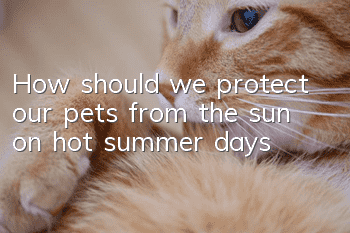How should we protect our pets from the sun on hot summer days?

The calendar for August has begun counting, which means that half of summer has passed, but the hottest weather has just begun.
What we absolutely cannot do without in summer is sun protection to save life, and air conditioning to extend life. The furry kids around you also need "sun protection" and "air conditioning" to stay calm.
Only when their emotions are stable can the safety of our lives and property be guaranteed. This summer’s limited edition poop shoveling special, here are all the ways to protect yourself from the sun and heatstroke👇.
Refuse to get sunburned
Cats have always loved basking in the sun. If you leave it to them to answer the question "Which one would you choose, the sun or you?", the answer will definitely not be you. It’s also difficult to completely avoid the sun when walking a dog. You can’t just wake the dog up from sleep and go out for a walk, right?
The inescapable summer sun is undoubtedly a threat to furry children.
UV (ultraviolet) light can penetrate the skin and cause changes within cells, leading to skin aging and several types of cancer.
UVA rays can induce aging and cause skin cancer. However, these rays cannot be filtered out and they can penetrate glass and penetrate deeper into the skin than UVB rays.
UVB rays, which often cause symptoms associated with sunburn, tend to penetrate the shallower layers of the skin. In severe cases, solar dermatitis may develop.
Q1
What are the risks of sunburn?
Sunburn is not just painful, it can lead to more serious problems, such as certain types of skin cancer, squamous cell carcinoma, malignant melanoma and hemangioma.
Sunburn can also exacerbate certain conditions, such as autoimmune diseases and solar dermatitis, and may cause discomfort at the surgical site.
Note: After sunburn, you can apply cold compress to your furry child’s skin to relieve the sting of the burn. However, the specific operation is still left to professional veterinarians.
Q2
Differences in varieties and parts,
Will there be any changes under the influence of ultraviolet rays?
Breeds with white hair and shorter hair are more susceptible to sunburn. Such as hairless cats, short-haired cats, bulldogs, shepherd dogs, Dalmatians, etc. The epidermis is highly exposed to UV rays and there is less pigmentation in the skin, putting them at a higher risk of sunburn than other breeds of dogs and cats.
Areas with less hair coverage, such as lips, ears, eyelids and nose, groin, legs, etc., are more likely to be sunburned.
Q3
What are the symptoms of sunburn?
■Skin allergies cause itching
■Dry skin
■ Hair loss occurs when licking wounds
■ Damage to the tissue within the skin causes pain around the area.
■Redness and inflammation of the skin
Q4
How should furry children protect themselves from the sun?
■ Escape sun protection
The most intense ultraviolet rays of the day are between 9 a.m. and 4 p.m. Keeping them away from direct sunlight is the most effective way to protect yourself from the sun.
■ Physical sunscreen
Provide plenty of shade, use blackout curtains or apply blackout window film at home;
Wear light and comfortable light-colored outerwear, or professional pet sun protection clothing with SPF.
Note: Pet sun protection clothing is made of fabric with ultraviolet protection factor (UPF). 50+UPF means only 1/50 of the sun's UV rays reach the skin.
You can even protect your pet with a hat and goggles to help them reduce glare damage (and look cool). You should know that ultraviolet rays can also cause the formation of melanoma in the eyes of pets.
When going out, you should avoid walking on extremely hot roads, or wear shoes to protect yourself. Furry children's paws are easily burned by the ground absorbing a lot of heat.
■ Chemical sunscreen
When high-intensity outdoor activities are unavoidable, consider applying safe sunscreen to furry children in areas prone to sunburn.
Q5
How to choose sunscreen for furry children?
The sunscreen your furry child needs must provide UVB and UVA protection, and the sun protection factor should be 15 or higher, such as SPF 30.
Try to choose sunscreen that is fragrance-free and waterproof, and avoid some seriously toxic ingredients, such as zinc oxide and para-aminobenzoic acid (PAB).A) and various derivatives of ethanol and salicylic hydrochloric acid, etc.
Zinc poisoning will cause vomiting, diarrhea and lethargy in the short term, and further symptoms such as dehydration and discoloration of excrement. PABA can cause severe organ damage.
Domestic pet sunscreen is not very popular, and with so many restrictions and requirements, it is difficult to choose a sunscreen suitable for furry children. You can consider baby sunscreen or sunscreen suitable for sensitive skin.
When applying, use a small amount as the principle. Even if you accidentally encounter sunscreen with toxic ingredients, you can still control the dosage.
Q6
Apply sunscreen to your furry child,
What should we pay attention to?
Apply a small amount to a certain area and test to make sure your furry child will not have an allergic reaction before using it.
Apply sunscreen about 15 to 20 minutes before going out. Prevent your furry child from licking the area for about 15 minutes. During this time, you need to keep an eye on your furry child to prevent the sunscreen from being licked until the sunscreen is absorbed into the skin.
When applying sunscreen to your furry child, treat them the same way you would a child and avoid rough application. Avoid eyes, ears and inside nose to avoid any irritation.
Even if products are waterproof, they will need to be reapplied every 4-6 hours if they are swimming or outdoors.
Note: Cats groom more frequently and are more likely to lick sunscreen. And based on the fact that most cats are unwilling to go out for a walk, it is recommended that cat owners use more physical sun protection measures.
Q7
What foods?
Can dogs enhance their ability to resist ultraviolet rays?
■ Orange vegetables and fruits (β-carotene, α-carotene)
■ Kelp (carotenoids and amino acids)
Krill (Astaxanthin super carotenoid and Omega 3)
■ Pure green tea (polyphenols)
■ Some berries (flavanols and polyphenols)
Say no to heatstroke
■Indoors
Use blackout curtains or window film, turn on the air conditioner and let your furry children experience the progress of science and technology and the greatness of mankind;
Comb your pet’s hair oftenhair, keeping it in a fluffy state, which is more conducive to the heat dissipation of furry children;
Keep the water supply sufficient and add ice cubes to the water bowl appropriately to cool down;
Prepare a cooling pad, wrap it in a towel and place it indoors for your furry kids to enjoy the cat and dog life.
■Outdoors
Using a breathable pet backpack, my beauty can be seen by others;
Prepare pure water spray and spray to cool down if necessary;
Walk your dog with water. When your dog is panting and becoming sluggish, take him to a shady area and give him some water. Whether it can save my dog's life may depend on this water.
The symptoms and reactions of furry children suffering from solar dermatitis are as follows:
Initial stages - Solar dermatitis may look like scaly skin or red skin;
In the middle and late stages - ulcers and scabs may develop.
Another sign that your furry child may have this condition is that they shake their head or scratch at the affected area.
Solar dermatitis usually appears on the face and ears, but we can also see it around the eyes, eyelids, and lips. Because these areas don’t have much hair to protect the skin.
- Is Turkish Angora cat easy to raise?
- What should I do if my British shorthair cat is infected with cat ringworm?
- Will the first cat be jealous if I get a second cat?
- How many grams of cat food should a cat eat per day?
- The kitten's breathing rumbled
- How to make a cat obediently cooperate with training? Cat training!
- Garfield cat breeding patterns and colors
- Why do cats love to lick their owners? Do they think they are too dirty?
- How to raise Garfield cats?
- What should I do if there are lumps of eye droppings in the corners of Persian cat’s eyes? How to deal with it?



